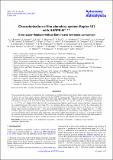Characterization of the planetary system Kepler-101 with HARPS-N : A hot super-Neptune with an Earth-sized low-mass companion
Date
12/2014Author
Funder
Grant ID
ST/J001651/1
ST/I000666/1
PP/D000890/1
ST/G001006/1
PP/F000065/1
Keywords
Metadata
Show full item recordAbstract
We characterize the planetary system Kepler-101 by performing a combined differential evolution Markov chain Monte Carlo analysis of Kepler data and forty radial velocities obtained with the HARPS-N spectrograph. This system was previously validated and is composed of a hot super-Neptune, Kepler-101b, and an Earth-sized planet, Kepler-101c. These two planets orbit the slightly evolved and metal-rich G-type star in 3.49 and 6.03 days, respectively. With mass Mp = 51.1-4.7+ 5.1 M⊕, radius Rp = 5.77-0.79+ 0.85 R⊕, and density ρp = 1.45-0.48+ 0.83 g cm-3, Kepler-101b is the first fully characterized super-Neptune, and its density suggests that heavy elements make up a significant fraction of its interior; more than 60% of its total mass. Kepler-101c has a radius of 1.25-0.17+ 0.19 R⊕, which implies the absence of any H/He envelope, but its mass could not be determined because of the relative faintness of the parent star for highly precise radial-velocity measurements (Kp = 13.8) and the limited number of radial velocities. The 1σ upper limit, Mp< 3.8 M⊕, excludes a pure iron composition with a probability of 68.3%. The architecture of the planetary system Kepler-101 − containing a close-in giant planet and an outer Earth-sized planet with a period ratio slightly larger than the 3:2 resonance − is certainly of interest for scenarios of planet formation and evolution. This system does not follow the previously reported trend that the larger planet has the longer period in the majority of Kepler systems of planet pairs with at least one Neptune-sized or larger planet.
Citation
Bonomo , A S , Sozzetti , A , Lovis , C , Malavolta , L , Rice , K , Buchhave , L A , Sasselov , D , Cameron , A C , Latham , D W , Molinari , E , Pepe , F , Udry , S , Affer , L , Charbonneau , D , Cosentino , R , Dressing , C D , Dumusque , X , Figueira , P , Fiorenzano , A F M , Gettel , S , Harutyunyan , A , Haywood , R D , Horne , K , Lopez-Morales , M , Mayor , M , Micela , G , Motalebi , F , Nascimbeni , V , Phillips , D F , Piotto , G , Pollacco , D , Queloz , D , Ségransan , D , Szentgyorgyi , A & Watson , C 2014 , ' Characterization of the planetary system Kepler-101 with HARPS-N : A hot super-Neptune with an Earth-sized low-mass companion ' , Astronomy & Astrophysics , vol. 572 , A2 . https://doi.org/10.1051/0004-6361/201424617
Publication
Astronomy & Astrophysics
Status
Peer reviewed
ISSN
0004-6361Type
Journal article
Description
The research leading to these results has received funding from the European Union Seventh Framework Programme (FP7/2007-2013) under Grant Agreement No. 313014 (ETAEARTH). R.D. Haywood acknowledges support from an STFC postgraduate research studentshipCollections
Items in the St Andrews Research Repository are protected by copyright, with all rights reserved, unless otherwise indicated.

